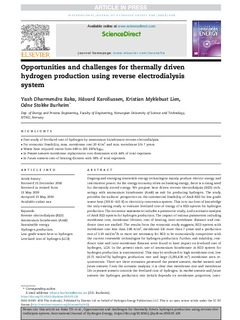| dc.description.abstract | Ongoing and emerging renewable energy technologies mainly produce electric energy and intermittent power. As the energy economy relies on banking energy, there is a rising need for chemically stored energy. We propose heat driven reverse electrodialysis (RED) technology with ammonium bicarbonate (AmB) as salt for producing hydrogen. The study provides the authors’ perspective on the commercial feasibility of AmB RED for low grade waste heat (333 K–413 K) to electricity conversion system. This is to our best of knowledge the only existing study to evaluate levelized cost of energy of a RED system for hydrogen production. The economic assessment includes a parametric study, and a scenario analysis of AmB RED system for hydrogen production. The impact of various parameters including membrane cost, membrane lifetime, cost of heating, inter-membrane distance and residence time are studied. The results from the economic study suggests, RED system with membrane cost less than 2.86 €/m2, membrane life more than 7 years and a production rate of 1.19 mol/m2/h or more are necessary for RED to be economically competitive with the current renewable technologies for hydrogen production. Further, salt solubility, residence time and inter-membrane distance were found to have impact on levelized cost of hydrogen, LCH. In the present state, use of ammonium bicarbonate in RED system for hydrogen production is uneconomical. This may be attributed to high membrane cost, low (0.72 mol/m2/h) hydrogen production rate and large (1,281,436 m2) membrane area requirements. There are three scenarios presented the present scenario, market scenario and future scenario. From the scenario analysis, it is clear that membrane cost and membrane life in present scenario controls the levelized cost of hydrogen. In market scenario and future scenario the hydrogen production rate (which depends on membrane properties, inter-membrane distance etc.), the cost of regeneration system and the cost of heating controls the levelized cost of hydrogen. For a thermally driven RED system to be economically feasible, the membrane cost not more than 20 €/m2; hydrogen production rate of 3.7 mol/m2/h or higher and cost of heating not more than 0.03 €/kWh for low grade waste heat to hydrogen production. | nb_NO |

